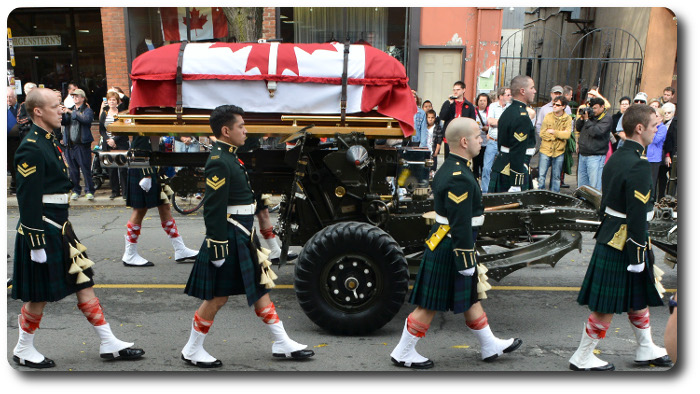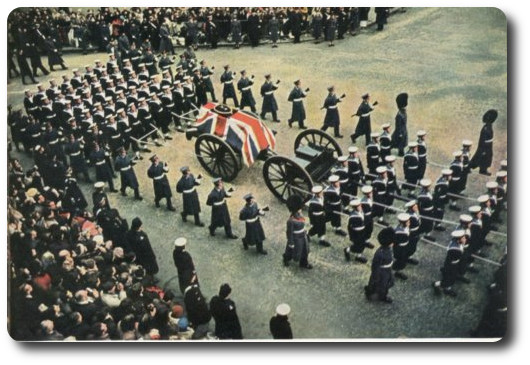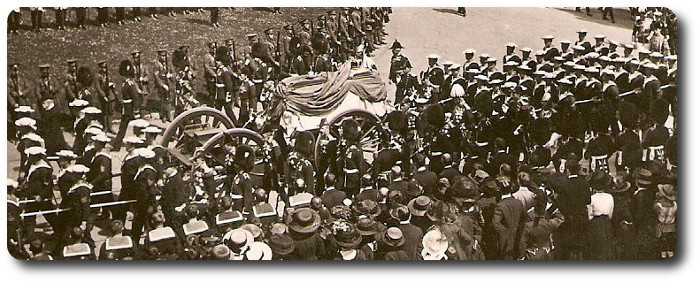Topic: Tradition

The gun carriage used in the funeral procession of Corporal Nathan Cirillo, Argyll and Sutherland Highlanders of Canada (Princess Louise's), on 28 October, 2014, in Hamilton, Ontario.
A Gun Carriage for Final Trip
Quebec Chronicle-Telegraph; 21 March 1967
By Patrick Nicholson
Many Ottawans lining the streets at the funeral of the late Governor General Vanier—and no doubt many more television viewers were intrigued by the transportation of the coffin.
Why, they wondered, was it not driven in the usual glass-walled Cadillac hearse?
Why was it drawn on an artillery carriage by men of the Royal Canadian Navy?
This is a tradition at state funerals. Many will remember the impressive phalanx of naval bluejackets which was so prominent at the funeral procession of Churchill.
But it is not old, as traditions go, dating only from the funeral of Queen Victoria on February 2, 1902.
Like many of the trappings of tradition prone navies, its English origin has been adopted by other countries; just as many navies copy the British sailor's uniform in adding three white stripes around the collar, commemorating the three great victories of history's most famous sailor, Nelson.

Bluejackets drawing the gun carriage in the state funeral of Sir Winston Churchill.
Great White Queen
Queen Victoria died at her favourite home, Osborne House in the Isle of Wight, in the 82nd year of her life and the 64th year of her reign.
He body was brought by train to Windsor for the funeral service in that historic castle; from that point I will quote an eye-witness account, from the Times newspaper of London, of Feb. 4, 1901:
"After the Queen's remains had been transferred from the royal train and placed upon the gun carriage, the procession began to move up to the mournful roll of the muffled drums. Chopin's 'Marche Funebre' by the band, the funeral tolling of the Castle bells, and the salute fired by the 'Eagle' battery of the Royal Horse Artillery.
"At this moment an unfortunate incident marred, for a time, the progress of the cortege. The artillery horse, which for some reason had become rather restless, had only moved a few paces when one of them reared and plunged in an exceeding dangerous manner in front of the gun carriage, behind which the King, the German Emperor, and the Duke of Connaught were walking.
"All attempts to pacify the animal were altogether unavailing, and at last, as the procession was being seriously delayed, the entire team was removed and their places were taken by a large number of Bluejackets who formed the Naval guard of honour.
"With their ever ready handiness, they turned the traces and chains of the harness into draw ropes, fitted them to the gun carriage, and themselves drew it with its precious burden from the station to the chapel.
"The King later sent a message to the Naval Brigade, conveying his thanks for the timely aid which they had rendered and for the seamanlike manner in which they had carried out their unexpected duty."

Bluejackets drawing the gun carriage in the state funeral of King Edward VII.
A Tradition is Born
Still in the charming leisurely prose of that day, the Times commented editorially:
"Even at the awkward contretemps at Windsor, when the artillery horses refused to move and were quickly replaced by Bluejackets, is scarcely to be regretted, since it served to show once more the resourcefulness, the utility and the ubiquity of the Navy."
Ever since then at state funerals in England—and in some other countries—naval bluejackets have been accorded the honoured role of hauling from front, and restraining from the rear, the gun carriage bearing the coffin.
The officers in command of Queen Victoria's last naval guard of honour, who masterminded that improvised human team, were Lieut. A. Boyle of HMS Excellent, Sub-Lieut. Percy Noble of the Royal Naval College, and Midshipman Stanley Holbrook, of HMS Majestic.
Boyle, a son of the Earl of Shannon, rose to be Admiral and died in 1949. Stanley Holbrook also ended a distinguished career in the Royal Navy at the rank of Admiral, and now lives in retirement in England.

